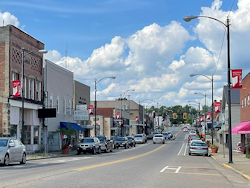SEJournal Online is the digital news magazine of the Society of Environmental Journalists. Learn more about SEJournal Online, including submission, subscription and advertising information.
 |
 |
| The author, at left, interviews an artist earlier this spring about her use of eucalyptus bark for screen printing and natural dyes in the Berkeley Hills of California. Photo: Joel Cohen. |
Feature: Rethinking Rural Reporting — How To Get Past the Cliches
By Claire Carlson
 |
Rural people are the last demographic that progressives “still mock with impunity.”
Barbara Kingsolver expressed this opinion in a 2023 interview about her book “Demon Copperhead,” which features rural Appalachians. “The news, the movies, TV, it’s all manufactured in cities about city people,” Kingsolver said. “[Rural people] are nothing. We don’t see ourselves at all. And if we do show up, it’s as a joke, the hillbillies.”
Kingsolver’s observations ring true for much of the contemporary media produced in the United States. These rural caricatures oversimplify what rural America is and who its residents are, and this can have grave implications for how rural communities are supported.
Even though one-fifth of America’s
population lives in rural places,
federal investments are sparse at best.
Even though one-fifth of America’s population lives in rural places, federal investments are sparse at best. The three biggest climate laws passed by the Biden administration allocated only 2.3% of the total funding exclusively to rural communities, even though studies show rural places have significant greenhouse gas emissions reduction potential because of the industries located there.
This rural disinvestment ripples into the rest of America: Urban and suburban communities rely on the resources many rural places produce, whether it be food or timber or energy from a wind farm.
From purely a resources standpoint, urbanites and suburbanites should care when a flood or fire hits a rural community because at some point, whether it was 50 years ago or now, that community probably helped build the city they currently live in.
Yet state and federal governments have largely ignored the contributions of rural America, and the way journalists talk about these places — remote, isolated, depressed — allows people to think small towns are a lost cause, places not worth funding. Everyone suffers because of this.
Steeped in politics
Rural stereotypes are steeped in politics. The common perception is that rural is Republican, urban is Democrat and suburban is a toss-up.
 |
| Downtown East Palestine, Ohio, six months before a 2023 train derailment and toxic chemical spill transformed it, the author writes, from a small town with its own story into a tragic national headline. Photo: 636Buster via Wikipedia (CC BY-SA 4.0). |
Moreover, rural America is blamed for driving today’s particular brand of right-wing extremism, as embodied by Donald Trump.
Yet data shows that arrestees from the Jan. 6, 2021, insurrection — a prime sampling of Trump’s devotees — were no more likely to be from a rural area than an urban or suburban location.
Even so, rural people are generally painted as racist, homophobic and predominantly white. They’re also called out as climate deniers and polluters, enemies of the environment. Rural America represents everything progressives eschew. Or at least that’s what some depictions would have you believe.
But these depictions are as one-dimensional as they can get. Sure, some rural people fall into these categories, but so do some city folks. There is nothing inherent about political ideology and locale.
Looking beyond the stereotypes
So what can journalists do to report richer stories about rural people and places?
We can start by talking to rural residents about the issues they’re facing rather than only going to the academics and professionals.
If you don’t know how to make those local connections, ask your expert sources for suggestions on who from the community you should talk to. If those experts don’t have an answer, perhaps they’re not the authoritative voices you’re looking for after all.
And while it is essential to talk to people who fall outside of the stereotypes the public has come to know rural America by, I also encourage journalists to talk to the supposed Trump devotees. Chances are their stories are just as complicated as anyone else’s.
The current state of journalism has
made it much harder for reporters to
take the time to understand the people
at the center of the stories we tell.
The current state of journalism has made it much harder for reporters to take the time to understand the people at the center of the stories we tell. Very few rural communities have local newspapers anymore, so the stories that are written about those communities are often by an outside publication.
This type of reporting (what many would call parachute journalism) is inevitable because of these news deserts, but one-dimensional rural caricatures don’t have to be the inevitable product of this journalism.
Understanding the stereotypes that rural America has been victim to and working to weed these stereotypes from our writing is the first step to richer rural reporting.
Not just tragedies
The second step is seeking out and telling rural stories that reflect the full range of rural experience.
National or regional outlets — which more and more are the only news outlets left — tend to write about rural communities only when a tragedy happens.
East Palestine, Ohio, is a good example of this. The 2023 train derailment that spilled hazardous chemicals in this community inundated national headlines for weeks and the town became known for its tragedy. But what was this place before a train derailment defined it? None of the stories I read ever told that part of the story.
Now, East Palestine is known by many as just another struggling small town that no one would want to live in. Too many rural stories featured in big news outlets share this plot.
Good and interesting things happen in rural places just as often as in urban ones. It’s up to us to tell those stories, too, if only to offer people an understanding of rural America that reflects the nuance and diversity that has always been there.
[Editor’s Note: Material for this story was drawn from a panel session moderated by Carlson at the Society of Environmental Journalists’ annual conference in Philadelphia in April 2024, whose sponsors are listed here. Listen to the panel’s full audio recording here and read a writeup from SEJournal’s student newsroom coverage.]
Claire Carlson is an environmental reporter for The Daily Yonder, a national nonprofit news organization that covers rural America. Among many environmental issues, she’s written extensively about the challenges rural communities face in accessing federal resources to fund climate resilience projects. Born and raised in northern Nevada, Claire now lives in Portland, Oregon. She has a master’s degree in environmental studies from the University of Montana.
* From the weekly news magazine SEJournal Online, Vol. 9, No. 25. Content from each new issue of SEJournal Online is available to the public via the SEJournal Online main page. Subscribe to the e-newsletter here. And see past issues of the SEJournal archived here.













 Advertisement
Advertisement 



